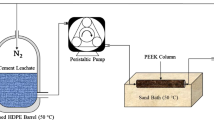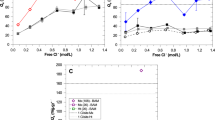Abstract
Saline solution properties, viscosity in particular, are shown to be critical in salt weathering associated with sodium and magnesium sulfate crystallization in porous limestone. The crystallization of sodium and magnesium sulfate within a porous limestone has been studied at a macro- and microscale using different techniques, including mercury intrusion porosimetry, environmental scanning microscopy and X-ray computed tomography. Such analysis enabled the visualization of the crystallization process in situ, and at high magnification, yielding critical information as to where and how salts crystallize. Sodium sulfate decahydrate (mirabilite) tends to crystallize in large pores as euhedral micron-sized crystals formed at low supersaturation near to the surface of the stone. In contrast, magnesium sulfate heptahydrate (epsomite) tends to precipitate as anhedral wax-like aggregates formed at high supersaturation and distributed homogeneously throughout the stone pore system filling large and small pores. While the former crystallization behavior resulted in scale formation, the latter led to crack development throughout the bulk stone. Ultimately, the contrasting weathering behavior of the two sulfates is explained by considering differences in flow dynamics of solutions within porous materials that are mainly connected with the higher viscosity of magnesium sulfate saturated solution (7.27 cP) when compared with sodium sulfate saturated solution (1.83 cP). On the basis of such results, new ways to tackle salt weathering, particularly in the field of cultural heritage conservation, are discussed.












Similar content being viewed by others
References
ASTM C 88–90 (1997) Standard test method for soundness of aggregate by use of sodium sulfate or magnesium sulfate. Annual Book of ASTM Standard 4.2:37–42
Benavente D, García del Cura MA, Fort R, Ordóñez S (1999) Thermodynamic modelling of changes induced by salt pressure crystallisation in porous media of stone. J Cryst Growth 204:168–178
Benavente D, García del Cura MA, García-Guinea J, Sánchez-Moral S, Ordóñez S (2004) Role of pore structure in salt crystallization in unsaturated porous stone. J Cryst Growth 260:532–544
Braitsch O (1971) Salt deposits: their origin and composition. Springer, Berlin Heidelberg New York
Correns CW (1949) Growth and dissolution of crystals under linear pressure. Discuss Faraday Soc 5:267–271
Coussy O (2006) Deformation and stress from in-pore drying-induced crystallization of salt. J Mech Phys Solids 54:1517–1547
CRC Handbook of Chemistry and Physics (2005) Lide DR (eds), CRC Press, Boca Raton
Dei LM, Mauro M, Baglioni P, Del Fa CM, Fratini F (1999) Growth of crystal phases in porous media. Langmuir 15:8915–8922
De Thury H (1828) Sur la procédé proposé par M. Brard pour reconnaítre immédiatement que ne peuvent pas résister à la gelée, et que l’on désigne ordinairement par les noms de pierres gelives ou pierres gelisses. Annales de Chimie et de Physique 38:160–192
Evans IS (1970) Salt crystallization and rock weathering: A review. Revue Géomorphologie Dynamique 19:153–177
Everett DM (1961) The thermodynamics of frost damage to porous solids. Trans Faraday Soc 57:2205–2211
Flatt RJ (2002) Salt damage in porous materials: how high supersaturations are generated. J Cryst Growth 242:435–454
Good RJ, Mikhail RS (1981) The contact angle in mercury intrusion porosimetry. Powder Technol 29:53–62
Goudie AS (1986) Laboratory simulation of ‘‘the wick effect’’ in salt weathering of rock. Earth Surf Processes Landf 11:275–285
Goudie AS (1993) Salt weathering simulation using a single-immersion technique. Earth Surf Processes Landf 18:369–376
Goudie AS, Cooke RU (1984) Salt efflorescences and saline lakes: a distributional analysis. Geoforum 15:563–582
Goudie AS, Viles HA (1997) Salt weathering hazard. Wiley, London
Goudie AS, Viles HA, Parker AG (1997) Monitoring of rapid salt weathering in the central Namib Desert using limestone blocks. J Arid Environ 37:581–598
Gregg SJ, Sing KSW (1982) Adsorption, surface area and porosity. Academic, London
Ioannou I, Hall C, Hoff WD, Pugsley VA, Jacques SDM (2005) Synchrotron radiation energy-dispersive X-ray analysis of salt distribution in Lépine limestone. Analyst 130:1006–1008
Kaneuji M, Winslow DN, Dolch WL (1980) The relationship between aggregate’s pore size distribution and its freeze thaw durability in concrete. Cem Concr Res 10:433–441
Katz AJ, Thompson AH (1987) Prediction of rock electrical conductivity from mercury injection measurements. J Geophys Res 92:599–607
La Iglesia A, González V, López-Acevedo V, Viedma C (1997) Salt crystallization in porous construction materials. I. Estimation of crystallization pressure. J Cryst Growth 177:111–118
Levy HA, Lisensky GC (1978) Crystal-structures of sodium-sulfate decahydrate (Glauber’s salt) and sodium tetraborate decahydrate (borax): redetermination by neutron-diffraction. Acta Crystallographica B 34:3502–3510
Lewin SZ (1981) The mechanism of masonry decay through crystallization. In: Barkin SM (ed) Conservation of historic stone buildings and monuments. National Academy of Sciences, Washington, pp 120–144
Lowell S, Shields JE (1983) Hysteresis in mercury porosimetry. In: Rossington DR, Condrate RA, Snyder RL (eds) Advances in materials characterization. Plenum Press, New York, pp 133–146
Malin MC (1974) Salt weathering on Mars. J Geophys Res 79:3888–3894
Moscou L, Lub S (1981) Practical use of mercury porosimetry in the study of porous solids. Powder Technol 29:45–52
Mullin JW (1993) Crystallization. Butterworth-Heinemann, Oxford
Naruse H, Tanaka K, Morikawa H, Marumo F (1987) Structure of Na2SO4 (I) at 693 K. Acta Crystallographica B 43:143–146
Paulik J, Paulik F, Arnold M (1981) Dehydration of magnesium sulphate heptahydrate investigated by quasi isothermal-quasi isobaric TG. Thermochimica Acta 50:105–110
Pel L, Huinink HP, Kopinga K (2002) Ion transport and crystallization in inorganic building materials as studied by nuclear magnetic resonance. Appl Phys Lett 81:2893–2895
Ramalingom S, Podder J, Narayana Kalkura S, Bocelli G (2003) Habit modification of epsomite in the presence of urea. J Cryst Growth 247:523–529
Rijniers LA (2004) Salt crystallization in porous materials. PhD, Techniche Universiteit Eindhoven, Holland
Rijniers LA, Huinink HP, Pel L, Kopinga K (2005) Experimental evidence of crystallization pressure inside porous media. Phys Rev Lett 94:75503
Robson HL (1927) The system MgSO4–H2O from 68 to 240°. J Am Chem Soc 49:2772–2783
Rodriguez-Navarro C (1994) Causas y mecanismos de alteración de los materiales calcáreos de las catedrales de Granada y Jaén (Causes and mechanisms of decay of the calcareous stones in the Granada and Jaen Cathedrals) (in Spanish). PhD, University of Granada, Spain
Rodriguez-Navarro C (1998). Evidence of honeycomb weathering on Mars. Geophys Res Lett 25:3249–3252
Rodriguez-Navarro C, Doehne E (1999a) Salt weathering: influence of evaporation rate, supersaturation and crystallization pattern. Earth Surf Processes Landf 24:191–209
Rodriguez-Navarro C, Doehne E (1999b) Time-lapse video and ESEM: integrated tools for understanding processes in situ. Am Lab 31:28–35
Rodriguez-Navarro C, Doehne E, Sebastian E (2000a) How does sodium sulfate crystallize? Implications for the decay and testing of building materials. Cem Concr Res 30:1527–1534
Rodriguez-Navarro C, Doehne E, Sebastian E (2000b) Influencing crystallization damage in porous materials through the use of surfactants: experimental results using sodium dodecyl sulfate and cetyldimethylbenzylammonium chloride. Langmuir 16:947–954
Rodriguez-Navarro C, Linares-Fernandez L, Doehne E, Sebastian-Pardo E (2002) Effects of ferrocyanide ions on NaCl crystallization in porous stone. J Cryst Growth 243:503–516
Ruiz-Agudo E, Rodriguez-Navarro C, Sebastian E. (2006) Sodium sulfate crystallization in the presence of phosphonates: Implications in ornamental stone conservation. Cryst Growth Des 6: 1575–1583
Schaffer RJ (1932) The weathering of natural building stones. DSIR, Building Research Special Report No. 18. Stationary Office, London
Scherer GW (1999) Crystallization in pores. Cem Concr Res 29:1347–1358
Scherer GW (2004) Stress from crystallization of salt. Cem Concr Res 34:1613–1624
Steiger M (2005a) Crystal growth in porous materials-I: The crystallization pressure of large crystals. J Cryst Growth 282:455–469
Steiger M (2005b) Crystal growth in porous materials. II: Influence of crystal size on the crystallization pressure. J Cryst Growth 282:470–481
Sunagawa I (1981) Characteristics of crystal growth in nature as seen from the morphology of mineral crystals. Bull Miner 104:81–87
Thaulow N, Sahu S (2004) Mechanism of concrete deterioration due to salt crystallization. Mater Charact 53:123–127
Vaniman DT, Bish DL, Chipera SJ, Fialips CI, Carey JW, Feldman WC (2004) Magnesium sulphate salts and the history of water on Mars. Nature 431:663–665
Wellman HW, Wilson AT (1965) Salt weathering, a neglected geological erosive agent in coastal and arid environments. Nature 205:1097–1098
Weyl PK (1959) Pressure solution and the force of crystallization- A phenomenological theory. J Geophys Res 64:2001–2025
Winkler EM (1994) Stone in architecture. Springer, Berlin Heidelberg New York
Winkler EM, Singer PC (1972) Crystallization pressure of salt in stone and concrete. Geol SocAm Bull 83:3509–3513
Xie P, Beaudoin JJ (1992) Mechanism of sulphate expansion I. Thermodynamic principle of crystallization pressure. Cem Concr Res 22:631–640
Acknowledgments
This work has been financially supported by the European Commission VIth Framework Program, under Contract no. SSP1-CT-2003-501571, and the research group NRM-179 (Junta de Andalucía, Spain). The ESEM used is from CEAMA (Junta de Andalucía-Universidad de Granada). We thank I. Sanchez-Almazo (CEAMA) for her assistance during the ESEM study. The insightful comments and suggestions of three anonymous referees are acknowledged.
Author information
Authors and Affiliations
Corresponding author
Rights and permissions
About this article
Cite this article
Ruiz-Agudo, E., Mees, F., Jacobs, P. et al. The role of saline solution properties on porous limestone salt weathering by magnesium and sodium sulfates. Environ Geol 52, 269–281 (2007). https://doi.org/10.1007/s00254-006-0476-x
Received:
Accepted:
Published:
Issue Date:
DOI: https://doi.org/10.1007/s00254-006-0476-x




